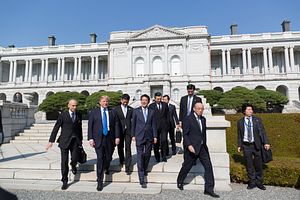U.S. President Donald Trump was in Japan on November 5 and 6, the first stop on his week-long Asia tour. Unsurprisingly, North Korea was a major focus of discussions between Trump and Japanese Prime Minister Shinzo Abe. Yet while the question of how Washington and Tokyo will combat North Korea’s nuclear ambitions drew headlines, another potentially significant development went largely overlooked: The United States and Japan unveiled their governments’ joint effort to offer an alternative to China’s Belt and Road Initiative (BRI).
The BRI is China’s plan to build infrastructure (from roads and railways to telecommunications and energy links) stretching from eastern Asia to western Europe. In the process, China will be forging closer economic and political links with nearly every country on the Eurasian continent – leading many in the United States to view the BRI as a geopolitical plot rather than the “win-win” effort China insists it is. In the past, U.S. officials have spoken disparagingly, if obliquely, about China’s Belt and Road Initiative, as my colleague Ankit Panda reported back in October. Secretary of Defense James Mattis told the Senate Armed Services Committee that “in a globalized world, there are many belts and many roads, and no one nation should put itself into a position of dictating ‘one belt, one road.’”
Secretary of State Rex Tillerson took the U.S. position a step further in an October speech, pointing out that “many Indo-Pacific nations have limited alternatives when it comes to infrastructure investment programs and financing schemes.” As a result, Tillerson indicated that the United States would seek to “expand transparent, high-standard regional lending mechanisms – tools that will actually help nations instead of saddle them with mounting debt.”
We now have a better idea of what that proposed alternative will look like – and importantly, it will involve a joint effort between the United States and Japan, which has its own reservations about China’s regional ambitions. As Abe put it during his joint press conference with Trump, “I am determined to see to it so that both Japan and U.S. strongly lead the regional and, eventually, the global economic growth by our cumulative efforts in creating fair and effective economic order in this region.”
According to a read-out from the White House, during Trump’s visit, the United States and Japan launched several initiatives designed to promote an alternative to Chinese infrastructure development in the Asia-Pacific (although China was never directly mentioned). First, two agreements were signed between Overseas Private Investment Corporation (OPIC), the U.S. government’s development finance agency, and Japanese partners “to offer high-quality United States-Japan infrastructure investment alternatives in the Indo-Pacific region.”
In its own press release, OPIC said its memoranda of understanding with the Japan Bank for International Cooperation (JBIC) and Nippon Export and Investment Insurance (NEXI) underscored a shared “commitment to tackling development challenges and bolstering investment in infrastructure, energy and other critical sectors throughout Asia and the Indo Pacific, the Middle East, and Africa.” The MOUs will allow the U.S. and Japanese finance institutions to cooperate and coordinate on “projects that meet policy objectives” in those regions – not coincidentally, also major areas of interest for the BRI.
Other agreements signed during Trump’s visit specifically deal with energy infrastructure. Both sides launched “the Japan-United States Strategic Energy Partnership to promote universal access to affordable and reliable energy in Southeast Asia, South Asia, and Sub-Saharan Africa.” The U.S. Trade and Development Agency (USTDA) and Japan’s Ministry of Economy, Trade and Industry (METI) also signed an agreement “to help bring high-quality energy infrastructure solutions to the Indo-Pacific region,” the White House statement said. According to the USTDA, the agreement will see it work with METI to “to support and promote international best practices in public procurement for infrastructure in third countries in emerging markets.”
All these new agreements stressed quality and affordability in infrastructure projects – two areas where the United States and Japan clearly believe China’s infrastructure offers are weak. In the words of USTDA, for example, its Memorandum of Cooperation with METI will help “demonstrate the high-quality value proposition that U.S. and Japanese companies excel at providing in infrastructure development.” By cooperating to provide alternative sources of funding and construction for infrastructure projects, the United States and Japan apparently hope to entice some potential BRI partners away from Chinese offers – although, notably, China and the Belt and Road are not specifically named in any of the announcements.
Tokyo and Washington have now formally joined forces to promote their countries as an alternative for the many Asian and African countries seeking to build up their infrastructure. The next step will be seeing if the United States and Japan expand their cooperation to include another major BRI critic, India. India and Japan already have a joint plan in place to advance cooperation on development projects in Africa, through the creation of the Asia-Africa Growth Corridor in November 2016. A trilateral agreement uniting all three countries would go a long way toward coordinating their responses to the BRI – provided their governments are actually willing to provide enough funding to truly counter China’s offers.

































